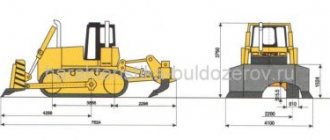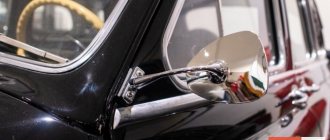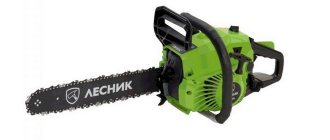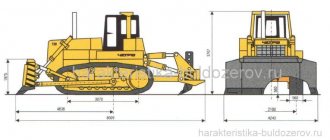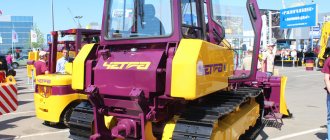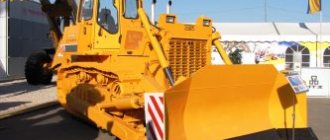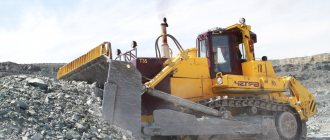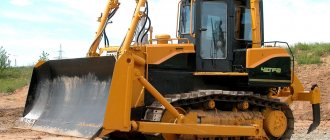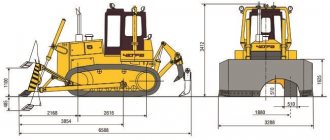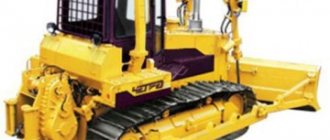Chetra T-11 is a heavy bulldozer tracked special equipment belonging to the 10th traction class. These bulldozers are used in road and construction work of the highest complexity, easily competing with imported analogues in all technical indicators.
The history of the creation of the Chetra T-11 bulldozer
The decision to build a new, large tractor plant was made in 1971, and in January 1972 its construction began. Simultaneously with the construction, recruitment was underway for the team of tractor builders of the new enterprise, the Cheboksary Industrial Tractor Plant or ChZTP.
Experienced specialists from such enterprises as ChTZ, PTZ, VgTZ, etc. were invited to lead positions. In the same 1972, recruitment began for ordinary positions, and young people from different parts of the country flocked to the new enterprise.
In December 1974, the first workshop of the plant began operating; components for the first tractor were manufactured on its premises. In 1975, on October 25, the technical control department accepted the first bulldozer of the ChZPT brand, a heavy T-330 with a power of 330 hp. This day is considered to be the birthday of the enterprise. In September 1982, the anniversary, 1000th tractor T-330 was manufactured.
Bulldozer T-330. In 1985, the development of a line of new industrial machines of 50, 35 and 25 tons was ready.
The first three T-25.01 bulldozers with a planetary gearbox were built. On its basis, a reclamation machine and a modification for pipe laying were created. At the end of 1993, ChZPT was privatized and transformed into Promtractor OJSC.
In 1995, the T-35 and T-25 tractors went into production; these machines were equipped with YaMZ diesel engines. Work on bulldozers with a power of 240 and 280 hp, called T-15 and T-20, began in 1996.
The T-20 was assembled first in the winter of 1997, and in October 1999 the first production T-15 was assembled. In the same 1999, the design of the T-11 began, it weighed 19 tons and the power reached 180 hp. The first T-11 bulldozer was manufactured in 2001, Sberbank took part in this project as an investor, and its mass production was launched in the same year.
In 2002, at the Tractor Show, where new tractor models were demonstrated, Promtractor OJSC for the first time presented to the public its products under the CHETRA brand. In June 2005, the company became part of the Tractor Plants LLC concern.
Order to reward an employee (form and sample). How to correctly fill out incentive orders
How to fill out an incentive order correctly
An employer can reward its employees for the impeccable performance of their duties, conscientious work, and more. Encouragement can be expressed in the form of gratitude, a cash bonus, a certificate of honor or a valuable gift, as well as in the form of a nomination for the title of the best in their profession.
In order to give an employee a bonus, the head of the enterprise issues a special order to reward the employee. The basis for it is usually a petition from the head of a particular division of the company, but it can also be other documents confirming the merits of the recipient (for example, confirming his work experience at the enterprise). As for the order itself, here you don’t have to invent or invent anything. The document is not only unified, but also approved by the State Statistics Committee.
You will need a standard T-11 form. You need to enter the name of the company in it as it is written in your constituent documents. If you are an individual entrepreneur, enter your OKPO code in the employee incentive order. The document number and date of the order are entered in accordance with current data. In the order to reward an employee, you must also enter the personnel number of the employee whom you want to reward, his full last name, first name and patronymic, the name of the department (structural unit) where he works, and the name positions (according to the staffing table).
The incentive motive is written with a small letter. This could be, for example, “high achievements in work”, “conscientious performance of official duties”, etc. In the “grounds for encouragement” field, enter the name of the basis document (for example, a petition from the head of a department).
Now all that remains is to sign the document. The first person to do this is the head of the organization, its first person - he enters the name of his position (for example, general director, chairman of the board of directors or president), last name and initials and signs. After this, the order is certified by the company’s seal. After reading the incentive order, the employee also puts his signature on it and indicates the date of signing.
class365.ru
Technical characteristics of the bulldozer Chetra T-11
The T-11 bulldozer was created to work in all climatic zones; the machine feels great both at -50 in the north and in southern latitudes at temperatures up to +50. Maintainability and ease of maintenance are ensured by the modular design of the tractor components and parts. Each module can be separately dismantled and transported to a repair shop, leaving a multi-ton machine in place.
The tractor was developed together with the German concern Sauer Danfoss taking into account modern requirements, therefore the T-11 includes components and assemblies of domestic and foreign production.
Let's look at the bulldozer in more detail.
Dimensions and weight of the tractor:
- Length – 6588 mm;
- Width – 3854 mm;
- Height – 3412 mm;
- Base – 2616 mm;
- Weight with ripper, blade and internal combustion engine, YaMZ/Cummins – 20785/19975 kg.
Engine of the bulldozer Chetra T-11
CHETRA T-11 is equipped with diesel engines of two different brands:
- Domestic YaMZ-236ND2;
- American Cummins QSB6.7-C204.
The Yaroslavl Motor Plant provided a V-shaped, four-stroke, six-cylinder, liquid-cooled diesel engine. With an engine capacity of slightly more than 11 liters, its power was 136 (185) kW (hp), with an engine speed of 1900 rpm. The cylinders have a diameter of 130 mm and a piston stroke of 140 mm. Torque produced at engine speeds of 1200-1400 rpm, approximately 883 Nm.
American machine manufacturers supply a six-cylinder, four-stroke, in-line unit with supercharging and liquid cooling. Thanks to supercharging and other design features, it was possible to extract 137.5 (187) kW (hp) from a volume of 6.7 liters at a maximum of 2000 rpm. The ratio of cylinder diameter and piston stroke is 102/136.4 mm. Torque at nominal engine speed of 1500 rpm, about 938 Nm.
The American diesel is slightly superior in characteristics to its Yaroslavl counterpart, and is also considered more reliable and economical. However, YaMZ is much easier to maintain and repairs are much cheaper; in addition, Yaroslavl diesel engines have passed more than one inspection by the north and received mostly positive reviews. Therefore, it is not easy to give a definite answer which engine is better, the main thing is that there is a choice.
Gearbox of the bulldozer Chetra T-11
The gearbox on the T-11 bulldozer is of a planetary type and has the ability to shift gears under load. The couplings operate in oil and are distinguished by their ability to transmit high torque values.
Provides the tractor with three speeds forward and the same number in reverse, the travel speed ranges from 3.7 to 11 km/h forward and backward from 5 to 14.4. The box, together with the main gear and matching gearbox, forms a single module installed in a special bore of the rear axle.
Device
The gearbox is planetary, which can shift under load. The number of gears is six: three rear and three forward. The functional unit, including the gearbox itself, the main gear and the gearbox, is located in the bore, which in turn is located in the rear axle.
| Broadcast | Forward travel, km/h | Reverse, km/h |
| 1 | 3.7 | 5.0 |
| 2 | 6.8 | 9.0 |
| 3 | 11.0 | 14.4 |
Transmission and chassis of the Chetra T-11 bulldozer
The hydrostatic transmission was developed above mentioned specifically for CHETRA brand bulldozers.
To reliably transfer torque from the diesel engine to the gearbox, a torque converter is used, which is connected to the engine using an elastic coupling and cardan drive.
The brakes are multi-disc clutches, closed constantly by spring force. Throughout the entire service life, they do not require adjustment, but are cooled using oil pressurized.
The tractor's suspension is semi-rigid, three-point. The remote swing axis of the bogies gives the bulldozer increased traction properties and reliable grip on the surface, and also protects the T-11 chassis from impact loads.
The idler wheels, and with them the support and support rollers, are equipped with self-pressing seals, the so-called “double cone”, and lifetime disposable lubrication. Each bulldozer tread has two support rollers and six support rollers.
The tracks of the T-11 tractor are prefabricated, each shoe has one lug, and to retain lubrication there is a seal in the hinge.
The surface area on which the caterpillar rests is 2.668 m2, while the pressure on the ground does not exceed 0.76 kg/cm2.
- The number of shoes in the caterpillar is 39 pcs;
- Links with pitch – 203 mm;
- Lugs height – 65 mm;
- Shoe width – 510 mm.
Steering and cabin of the bulldozer Chetra T-11
The T-11 is controlled using onboard clutches, multi-disc clutches driven hydraulically. By disconnecting (fully or partially) the clutches of the left or right side clutch, the bulldozer turns in the appropriate direction. The clutches are controlled from the control station using two levers.
The tractor cabin has double glazing, providing excellent visibility to all working areas and equipment. Equipped with heating and forced ventilation systems, and optionally with an air conditioning system.
The interior trim, the shape of the panels and controls have a modern design and are made of high-quality materials, and most importantly, they are located as conveniently as possible for the operator.
The gas pedal can be fixed in the selected position, providing the required engine speed. One lever is responsible for the direction (forward, backward) and gear shifting. Two small levers to the left of the driver control the side clutches. There are two separate levers to control the ripper and blade. All controls are accessible from the operator's seat, which helps reduce operator fatigue during the shift.
general description
The vehicles in question are equipped as standard: the power unit is located in the front, and the driver’s cabin is in the rear. The hydrostatic dual-circuit drive makes it possible to control position and speed separately on each wheel. This design allows you to move and make turns smoothly, which cannot be guaranteed with a conventional manual transmission.
Teaser network
The Liebherr bulldozer is controlled using one lever, which is responsible for movement, turns and braking. This ensures that the operator's workload is reduced, allowing him to fully concentrate on the work process. All modifications of equipment of this brand use different versions of the Litronik system, which is responsible for controlling all components of the machine, optimal distribution between speed indicators and traction force.
Hydraulics and attachments for the Chetra T-11 bulldozer
The separate-module system of the T-11 bulldozer includes:
- The S1A6097 gear pump produces a capacity of 163 l/min at an engine speed of 1800 rpm. ;
- Four-section distributor from , three working sections, one valve;
- The safety valve operates at pressures above 200 MPa;
- Welded hydraulic tank, capacity 85 l;
- Hydraulic cylinders 5 pcs. 2 for raising and lowering the blade, 1 for turning the blade left and right, 2 for raising and lowering the ripper.
Bulldozer equipment.
A large-capacity hemispherical blade provides the T-11 bulldozer with high performance. The use of diagonal traction when transferring lateral loads from the blade to the left spar of the bulldozer provides the greatest proximity of the blade to the hood and the greatest support force on the blade blade.
Ripper.
Depending on the required productivity, CHETRA bulldozers are equipped with rippers with one tooth, as well as with three or two teeth.
- Type of ripper – multi-shank/non-adjustable;
- Number of teeth – 3/1;
- Depth – 640/530 mm;
- Penetration force – 6.14/5.7 t;
- Pull-out force – 17.15/16 t.
Model 724 and 754 Features
754 series machine parameters:
- working weight - 34.9-42.4 tons;
- power - 250 kW;
- dump capacity - 4.9-11.7 cubic meters;
- speed - 11 km/h.
The Liebherr 724 bulldozer has no less quality parameters, like its predecessors, and has the following characteristics:
Teaser network
- working weight - 1.9-2.0 tons;
- blade dimensions - 3.2/1.2 m in length and height;
- dump capacity - 3.1-4.2 m;
- maximum thrust - 227 kN;
- engine power indicators - 118 kW;
- deepening/lifting of the working part - 0.52/1.1 m.
Modifications of the Chetra T-11 bulldozer
T-11 bulldozers can be equipped with engines from two manufacturers and various attachments and weights. For example: T-11.02YAB is equipped with a YaMZ-236 diesel engine, and its weight ranges from 20.87 to 23.4 tons; T-11.02K with a Commins diesel engine and a weight from 20.4 to 23.4 tons.
Also after the name you can find additional letters that are written for easier identification and designation:
- M – low pressure on the ground;
- C – presence of hydrostatic transmission;
- L – winch included;
- P - with a rotating blade.
Versions 736 and 734
These modifications have approximately the same characteristics. The 736th variation is distinguished by an improved electronic unit, an original design and a cabin with increased safety. There are two control joysticks and a monitor that allows you to monitor the actions of the equipment. The table shows the parameters of these machines, for comparison with the parameters of the popular model of the Liebherr 764 bulldozer.
| Indicators | |||
| Weight (t) | 20,3-24,5 | 20,4-24,5 | 44,2-52,7 |
| Blade dimensions (m) | 3,36/3,99/1,15 | 3,36/3,99/1,14 | |
| Motor power (kW) | |||
| Maximum traction force (kN) | |||
| Blade depth/raise (m) | 0,54/1,2 | 0,542/1,2 | |
| Working speed (km/h) |
Operation of Chetra T-11 bulldozers
The overwhelming number of machines of this class in our country operate in the difficult conditions of the north, Siberian and Far Eastern taiga. They develop oil and gas fields, and also participate in the exploration of new ones. They are laying oil and gas pipelines through wild, uninhabited places where there are no roads or infrastructure. They work in gold mining, in the mines of eastern Siberia and on the river. Kolyma.
In such difficult conditions, technology often works at the limits of what is possible, and the advantages, as well as the disadvantages, quickly manifest themselves:
Advantages.
- Adaptation of vehicles to northern conditions: pre-heating of the engine; additional, independent heater in the cabin, imported fuel filters with fuel heating and water separation functions;
- Modular design of components and systems, which increases maintainability and ease of maintenance;
- Reliable diesel engines YaMZ and Commins;
- Comfortable working conditions for the operator.
Chetra T-11 performs a stunt.
Flaws.
- Most often problems arise with hydraulics after operating for 2-3 thousand hours;
- Problems in the operation of the transmission (again in terms of hydraulics);
- In general, they are inferior in reliability and operating time to well-known foreign analogues.
- No longer track life.
